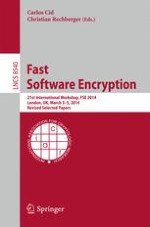2015 | Book
Fast Software Encryption
21st International Workshop, FSE 2014, London, UK, March 3-5, 2014. Revised Selected Papers
Editors: Carlos Cid, Christian Rechberger
Publisher: Springer Berlin Heidelberg
Book Series : Lecture Notes in Computer Science
